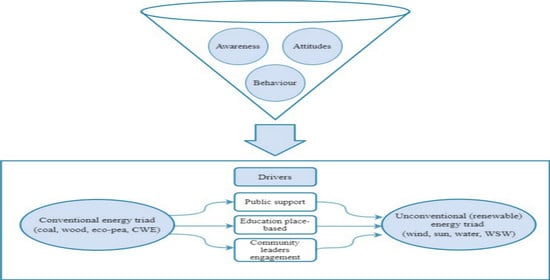Local Communities’ Energy Literacy as a Way to Rural Resilience—An Insight from Inner Peripheries
Abstract
1. Introduction
1.1. Energy Literacy
1.2. Rural Resilience
1.3. The Objective of the Study
2. Research Design, Case Study Description, and Methodology
2.1. Research Design
2.2. Case Study Description
2.3. Methodology
3. Research Results
3.1. An Outline of the Energy Situation of Households in Poland and Energy Attitudes and Behaviour of Polish Society
3.2. Energy Literacy of the Local Community
3.2.1. Resilient Households?
3.2.2. Local Communities’ Energy Awareness and Attitude
4. Discussion
4.1. Energy Awareness, Attitudes and Behaviour of the Locals—Hot and Blind Spots
4.2. The Core of Increasing the Locals’ Energy Literacy
5. Conclusions
Author Contributions
Funding
Institutional Review Board Statement
Informed Consent Statement
Data Availability Statement
Acknowledgments
Conflicts of Interest
References
- Beck, U. Społeczeństwo Ryzyka. W drodze do Innej Nowoczesności; Wydawnictwo Scholar: Warszawa, Poland, 2004. [Google Scholar]
- Strzelecka, E. Concept of Resilience and Development of Small Towns and Rural Area. Barom. Reg. 2018, 16, 121–130. [Google Scholar]
- Henderson, F.; Steiner, A.; Farmer, J.; Whittam, G. Challenges of community engagement in a rural area: The impact of flood protection and policy. J. Rural Stud. 2020, 73, 225–233. [Google Scholar] [CrossRef]
- Martins, A.; Madaleno, M.; Dias, M.F. Energy literacy assessment among Portuguese university members: Knowledge, attitude, and behavior. Energy Rep. 2020, 6, 243–249. [Google Scholar] [CrossRef]
- Coles, T.; Dinan, C.; Warren, N. Energy practices among small- and medium-sized tourism enterprises: A case of misdirected effort? J. Clean. Prod. 2014, 111 Pt B, 399–408. [Google Scholar] [CrossRef]
- Sovacool, B.K. Evaluating energy security in the Asia pacific: Towards a more comprehensive approach. Energy Policy 2011, 39, 7472–7479. [Google Scholar] [CrossRef]
- Van den Broek, K. Household energy literacy: A critical review and a conceptual typology. Energy Res. Soc. Sci. 2019, 57. [Google Scholar] [CrossRef]
- Robison, R.; Skjølsvold, T.M.; Lehne, J.; Judson, E.; Pechancová, V.; Foulds, C.; Bilous, L.; Büscher, C.; Carrus, G.; Darby, S.; et al. 100 Social Sciences and Humanities Priority Research Questions for Smart Consumption in Horizon Europe; Energy-SHIFTS: Cambridge, UK, 2020; Available online: https://energy-shifts.eu/wp-content/uploads/2020/12/D2.3_WG2_smart-consumption.pdf (accessed on 11 February 2021).
- Brounen, D.; Kok, N.; Quigley, J.M. Energy literacy, awareness, and conservation behavior of residential households. Energy Econ. 2013, 38. [Google Scholar] [CrossRef]
- Sovacool, B.K.; Blyth, P.L. Energy and environmental attitudes in the green state of Denmark: Implications for energy democracy, low carbon transitions, and energy literacy. Environ. Sci. Policy 2015, 54. [Google Scholar] [CrossRef]
- Carlsson-Kanyama, A.; Lindén, A.-L. Energy efficiency in residences—Challenges for women and men in the North. Energy Policy 2007, 35, 2163–2172. [Google Scholar] [CrossRef]
- DeWaters, J.E.; Powers, S.E. Energy literacy of secondary students in New York State (USA): A measure of knowledge, affect, and behavior. Energy Policy 2011, 39, 699–710. [Google Scholar] [CrossRef]
- DeWaters, J.; Qaqish, B.; Graham, M.; Powers, S. Designing an energy literacy questionnaire for middle and high school youth. J. Environ. Educ. 2013, 44, 56–78. [Google Scholar] [CrossRef]
- Lee, L.-S.; Lee, Y.-F.; Wu, M.-J.; Pan, Y.-J. A study of energy literacy among nursing students to examine implications on energy conservation efforts in Taiwan. Energy Policy 2019, 135. [Google Scholar] [CrossRef]
- Kalmi, P.; Trotta, G.; Kazukauskas, A. The role of energy literacy as a component of financial literacy: Survey-based evidence from Finland. In Proceedings of the IAEE Conference, Vienna, Austria, 3–6 September 2017. [Google Scholar]
- Blasch, J.; Boogen, N.; Daminato, C.; Filippini, M. Empower the Consumer! Energy-Related Financial Literacy and Its Socioeconomic Determinants; CER-ETH–Center of Economic Research: Zurich, Switzerland, 2018. [Google Scholar] [CrossRef]
- Martins, A.; Madaleno, M.; Dias, M.F. Energy literacy: What is out there to know? Energy Rep. 2020, 6, 454–459. [Google Scholar] [CrossRef]
- Remund, D.L. Financial literacy explicated: The case for a clearer definition in an increasingly complex economy. J. Consum. Aff. 2010, 44, 276–295. [Google Scholar] [CrossRef]
- Vainio, A.; Pulkka, A.; Paloniemi, R.; Varho, V.; Tapio, P. Citizens’ sustainable, future-oriented energy behaviours in energy transition. J. Clean. Prod. 2020, 245. [Google Scholar] [CrossRef]
- Folke, C. Resilience: The emergence of a perspective for social–ecological systems analyses. Glob. Environ. Chang. 2006, 16, 253–267. [Google Scholar] [CrossRef]
- Perez, C.; Jones, E.M.; Kristjanson, P.; Cramer, L.; Thornton, P.K.; Förch, W.; Barahona, C. How resilient are farming households and communities to a changing climate in Africa? A gender-based perspective. Glob. Environ. Chang. 2015, 34, 96–107. [Google Scholar] [CrossRef]
- Heijman, W.; Hagelaar, G.; van der Heide, M. Rural resilience as a new development concept. 100th Seminar, 21–23 June 2007, Novi Sad, Serbia and Montenegro from European Association of Agricultural Economists. Available online: https://EconPapers.repec.org/RePEc:ags:eaa100:162359 (accessed on 11 February 2021).
- Dacko, A.; Dacko, M. Studies on the Development of Rural Areas—From the Growth Paradigm to Resilience. Wieś i Rolnictwo 2018, 2, 49–64. [Google Scholar] [CrossRef]
- Adger, W.N.; Hughes, T.P.; Folke, C.; Carpenter, R.; Rockström, J. Social-Ecological Resilience to Coastal Disasters. Science 2005, 309, 1036–1039. [Google Scholar] [CrossRef] [PubMed]
- Miller, F.; Osbahr, H.; Boyd, E.; Thomalla, F.; Bharwani, S.; Ziervogel, G.; Walker, B.; Birkmann, J.; van der Leeuw, S.; Rockstrom, J.; et al. Resilience and vulnerability: Complementary or conflicting concepts? Ecol. Soc. 2010, 15, 11. [Google Scholar] [CrossRef]
- Umetsu, C. Vulnerability and Resilience of Social-Ecological Systems; Inter-University Research Institute Corporation, National Institutes for the Humanities Research Institute for Humanity and Nature: Kyoto, Japan, 2010. [Google Scholar]
- Schouten, M.; van der Heide, M.; Heijman, W.; Opdam, P. A resilience-based policy evaluation framework: Application to European rural development policies. Ecol. Econom. 2012, 81, 165–175. [Google Scholar] [CrossRef]
- Mazur, C.; Hoegerle, Y.; Brucoli, M.; van Dam, K.; Guo, M.; Markides, C.N.; Shah, N. A holistic resilience framework development for rural power systems in emerging economies. Appl. Energy 2019, 235, 219–232. [Google Scholar] [CrossRef]
- Bouzarovski, S.; Thomson, H. Transforming Energy Poverty Policies in The European Union: Second Annual Report of The European Union Energy Poverty Observatory. 2019. Available online: https://www.energypoverty.eu/sites/default/files/downloads/observatory-documents/20-01/epov_pan-eu_report_2019_final.pdf (accessed on 10 January 2021).
- Arsenopoulos, A.; Marinakis, V.; Koasidis, K.; Stavrakaki, A.; Psarras, J. Assessing Resilience to Energy Poverty in Europe through a Multi-Criteria Analysis Framework. Sustainability 2020, 12, 4899. [Google Scholar] [CrossRef]
- Kythreotis, A.P.; Bristow, G.I. The ‘resilience trap’: Exploring the practical utility of resilience for climate change adaptation in UK city-regions. Reg. Stud. 2017, 51, 1530–1541. [Google Scholar] [CrossRef]
- Skerrat, S.; Steiner, A. Working with communities-of-place: Complexities of empowerment. Local Econ. 2013, 28, 320–338. [Google Scholar] [CrossRef]
- Olave, M.S.; Vargas-Payera, S. Environmental impact assessment and public participation of geothermal energy projects: The cases of Chile, Costa Rica, Colombia, and Mexico. In The Regulation and Policy of Latin American Energy Transitions; Guimarães, L.N., Ed.; Elsevier Science: Amsterdam, The Netherlands, 2020. [Google Scholar]
- Zużycie Energii w Gospodarstwach Domowych w 2018 r. Główny Urząd Statystyczny, 2019. Available online: https://stat.gov.pl/download/gfx/portalinformacyjny/pl/defaultaktualnosci/5485/2/4/1/zuzycie_energii_w_gospodarstwach_domowych_w_2018.pdf (accessed on 11 February 2021).
- Local Data Bank of Statistics Poland, LDB SP. Available online: https://bdl.stat.gov.pl/ (accessed on 5 January 2021).
- Gorard, S. The role of secondary data in combining methodological approaches. Educ. Rev. 2002, 54, 231–237. [Google Scholar] [CrossRef]
- Owczarek, D.; Miazga, A. Ubóstwo Energetyczne w Polsce—Definicja i Charakterystyka Społeczna Grupy; Instytut na Rzecz Ekorozwoju: Warszawa, Poland, 2015; Available online: https://www.pine.org.pl/wp-content/uploads/pdf/ubostwo_energet_polska.pdf (accessed on 5 January 2021).
- Strategia Rozwoju Województwa Kujawsko-Pomorskiego do 2030 Roku—Strategia Przyspieszenia 2030+, Załącznik do Uchwały nr XXVIII/399/20 Sejmiku Województwa Kujawsko-Pomorskiego Z dnia 21 Grudnia 2020 r. Available online: https://kujawsko-pomorskie.pl/pliki/2020/planowanie/20201229_strategia/Strategia_Przyspieszenia_2030plus.pdf (accessed on 20 January 2021).
- Chodkowska-Miszczuk, J.; Martinat, S.; Cowell, R. Community tensions, participation, and local development: Factors affecting the spatial embeddedness of anaerobic digestion in Poland and the Czech Republic. Energy Res. Soc. Sci. 2019, 55, 134–145. [Google Scholar] [CrossRef]
- Lewandowska, A.; Chodkowska-Miszczuk, J.; Rogatka, K.; Starczewski, T. Smart Energy in a Smart City: Utopia or Reality? Evidence from Poland. Energies 2020, 13, 5795. [Google Scholar] [CrossRef]
- Babbie, E. Badania Społeczne w Praktyce; Wydawnictwo Naukowe PWN: Warszawa, Poland, 2004. [Google Scholar]
- Sato, J. Comparison between multiple-choice and analytic hierarchy process: Measuring human perception. Intl. Trans. Opt. Res. 2004, 11, 77–86. [Google Scholar] [CrossRef][Green Version]
- Francis, J.J.; Johnston, M.; Robertson, C.; Glidewell, L.; Entwistle, V.; Eccles, M.P.; Grimshaw, J.M. What is an adequate sample size? Operationalising data saturation for theory-based interview studies. Psychol. Health 2010, 25, 1229–1245. [Google Scholar] [CrossRef] [PubMed]
- Schwarz, N.; Hippler, H.J. What Response Scales may Tell your Respondents: Informative Functions of Response Alternatives. In Social Information Processing and Survey Methodology. Recent Research in Psychology; Hippler, H.J., Schwarz, N., Sudman, S., Eds.; Springer: New York, NY, USA, 1987. [Google Scholar] [CrossRef]
- Eurostat. Available online: https://ec.europa.eu/eurostat (accessed on 29 January 2021).
- Lewandowski, P.; Kiełczewska, A.; Ziółkowska, K. Zjawisko Ubóstwa Energetycznego w Polsce, w Tym ze Szczególnym Uwzględnieniem Zamieszkujących w Domach Jednorodzinnych. IBS Research Report 02/2018, Kwiecień 2018. Available online: https://ibs.org.pl/app/uploads/2018/06/IBS_Research_Report_02_2018_pl.pdf (accessed on 11 February 2021).
- Centrum Badania Opinii Społecznej. Polacy o źródłach Energii, Polityce Energetycznej i Stanie środowiska. Gwiazda, M., Ruszkowski, P., Eds.; Opinie i diagnozy nr 34. 2016. Available online: https://www.cbos.pl/PL/publikacje/diagnozy/034.pdf (accessed on 11 February 2021).
- Chodkowska-Miszczuk, J.; Biegańska, J.; Środa-Murawska, S.; Grzelak-Kostulska, E.; Rogatka, K. European Union funds in the development of renewable energy sources in Poland in the context of the cohesion policy. Energy Environ. 2016, 27, 713–725. [Google Scholar] [CrossRef]
- Dyląg, A. Świadomość ekologiczna i energetyczna młodzieży dużego i małego miasta w województwie łódzkim. In Bezpieczeństwo Energetyczne. Rynki Surowców i Energii—Teraźniejszość i Przyszłość. Geopolityka—Polska—Świat; Kwiatkiewicz, P., Ed.; Fundacja na Rzecz Czystej Energii: Bydgoszcz, Poland, 2014; pp. 401–420. [Google Scholar]
- Frazier, B.J.; Niehm, L.S. Exploring business information networks of small retailers in rural communities. J. Dev. Entrep. 2004, 9, 23–42. [Google Scholar]
- Rapaport, C.; Hornik-Lurieb, T.; Cohen, O.; Lahade, M.; Leykin, D.; Aharonson-Daniel, L. The relationship between community type and community resilience. Int. J. Disast. Risk Reduct. 2018, 31, 470–477. [Google Scholar] [CrossRef]
- Quinlan, M. Five challenges to humanity: Learning from pattern/repeat failures in past disasters? Econ. Lab. Relat. Rev. 2020, 31, 444–466. [Google Scholar] [CrossRef]
- Ogólnopolskie Badanie Wynagrodzeń w 2019 roku. 2020. Available online: https://wynagrodzenia.pl/artykul/jak-poziom-wyksztalcenia-wplywa-na-wynagrodzenie (accessed on 11 February 2021).
- Kapitał Ludzki w Polsce w Latach 2014–2018. Główny Urząd Statystyczny, 2020. Available online: https://stat.gov.pl/download/gfx/portalinformacyjny/pl/defaultaktualnosci/5501/8/7/1/kapital_ludzki_w_polsce_w_latach_2014-2018.pdf (accessed on 11 February 2021).
- Rosicki, E. Kultury Energetyczne Unii Europejskiej; Wydawnictwo Naukowe Wydziału Nauk Politycznych i Dziennikarstwa: Poznań, Poland, 2018. [Google Scholar]
- Żuk, P.; Żuk, P.; Pluciński, P. Coal basin in Upper Silesia and energy transition in Poland in the context of pandemic: The socio-political diversity of preferences in energy and environmental policy. Res. Policy 2021, 71, 101987. [Google Scholar] [CrossRef]
- Vanschoenwinkel, J.; Mendelsohn, R.; Van Passel, S. Do Western and Eastern Europe have the same agricultural climate response? Taking adaptive capacity into account. Glob. Environ. Chang. 2016, 41, 74–87. [Google Scholar] [CrossRef]
- Blasch, J.; Boogen, N.; Filippini, M.; Kumar, N. Explaining electricity demand and the role of energy and investment literacy on end-use efficiency of Swiss households. Energy Econ. 2017, 68, 89–102. [Google Scholar] [CrossRef]
- Blasch, J.; Filippini, M.; Kumar, N. Boundedly rational consumers, energy and investment literacy, and the display of information on household appliances. Resour. Energy Econ. 2019, 56, 39–58. [Google Scholar] [CrossRef]
- Carmi, N.; Arnon, S.; Orion, N. Transforming environmental knowledge into behavior: The mediating role of environmental emotions. J. Environ. Educ. 2015, 46, 183–201. [Google Scholar] [CrossRef]
- Echegaray, F.; Hansstein, F.V. Assessing the intention-behavior gap in electronic waste recycling: The case of Brazil. J. Clean. Prod. 2017, 142, 180–190. [Google Scholar] [CrossRef]
- Malkki, H.; Alanne, K. An overview of life cycle assessment (LCA) and research based teaching in renewable and sustainable energy education. Renew. Sustain. Energy Rev. 2017, 69, 218–231. [Google Scholar] [CrossRef]
- Pothitou, M.; Hanna, R.F.; Chalvatzis, K.J. Environmental knowledge, pro-environmental behaviour and energy savings in households: An empirical study. Appl. Energy 2016, 184, 1217–1229. [Google Scholar] [CrossRef]
- Pothitou, M.; Varga, L.; Kolios, A.J.; Gu, S. Linking energy behaviour, attitude and habits with environmental predisposition and knowledge. Int. J. Sustain. Energy 2017, 36, 398–414. [Google Scholar] [CrossRef]
- Sokołowski, J.; Lewandowski, P.; Kiełczewska, A.; Bouzarovski, S. A multidimensional index to measure energy poverty: The Polish case. Energy Sources Part B: Econ. Plan. Policy 2020, 15, 92–112. [Google Scholar] [CrossRef]
- Hess, D.J.; Maki, A. Climate change belief, sustainability education, and political values: Assessing the need for higher-education curriculum reform. J. Clean. Prod. 2019, 228, 1157–1166. [Google Scholar] [CrossRef]
- Brauers, H.; Oei, P.-Y. The political economy of coal in Poland: Drivers and barriers for a shift away from fossil fuels. Energy Policy 2020, 144, 111621. [Google Scholar] [CrossRef]
- Simcock, N.; Thomson, H.; Petrova, S.; Bouzarovski, S. (Eds.) Conclusions. In Energy Poverty and Vulnerability. A Global Perspective; Routledge: London, UK; New York, NY, USA, 2018. [Google Scholar]
- Boguszewski, R.; Herudziński, T. Ubóstwo Energetyczne w Polsce. Pracownia Badań Społecznych SGGW. 2018. Available online: https://www.cire.pl/pliki/2/2018/ubostwo_energetyczne_w_polsce_raport_03_09_2018.pdf (accessed on 11 February 2021).
- Kola-Bezka, M. Community-led local development in urban and other areas: Lessons from Kujawsko-Pomorskie voivodship. Econ. Law 2020, 19, 505–521. [Google Scholar] [CrossRef]
- Kola-Bezka, M. Are LAGs contributing to solving social exclusion problems? The case of Kujawsko-Pomorskie Voivodship. Bull. Geography. Socio-econ. Ser. 2020, 48, 35–45. [Google Scholar] [CrossRef]
- McManus, P.; Walmsley, J.; Argent, N.; Baum, S.; Bourke, L.; Martin, J.; Pritchard, B.; Sorensen, T. Rural Community and Rural Resilience: What is important to farmers in keeping their country towns alive? J. Rural Stud. 2012, 21, 20–29. [Google Scholar] [CrossRef]
- Gwosdz, K.; Domański, B.; Bilska-Wodecka, E. Localised capabilities as an intermediating factor in the transition from an old to a new development path: The case of post-socialist industrial towns. Morav. Geogr. Rep. 2020, 28, 124–135. [Google Scholar] [CrossRef]
- Van der Horst, D. Landscapes of lost energy: Counterfactual geographical imaginary for a more sustainable society. Morav. Geogr. Rep. 2014, 22, 66–72. [Google Scholar] [CrossRef]
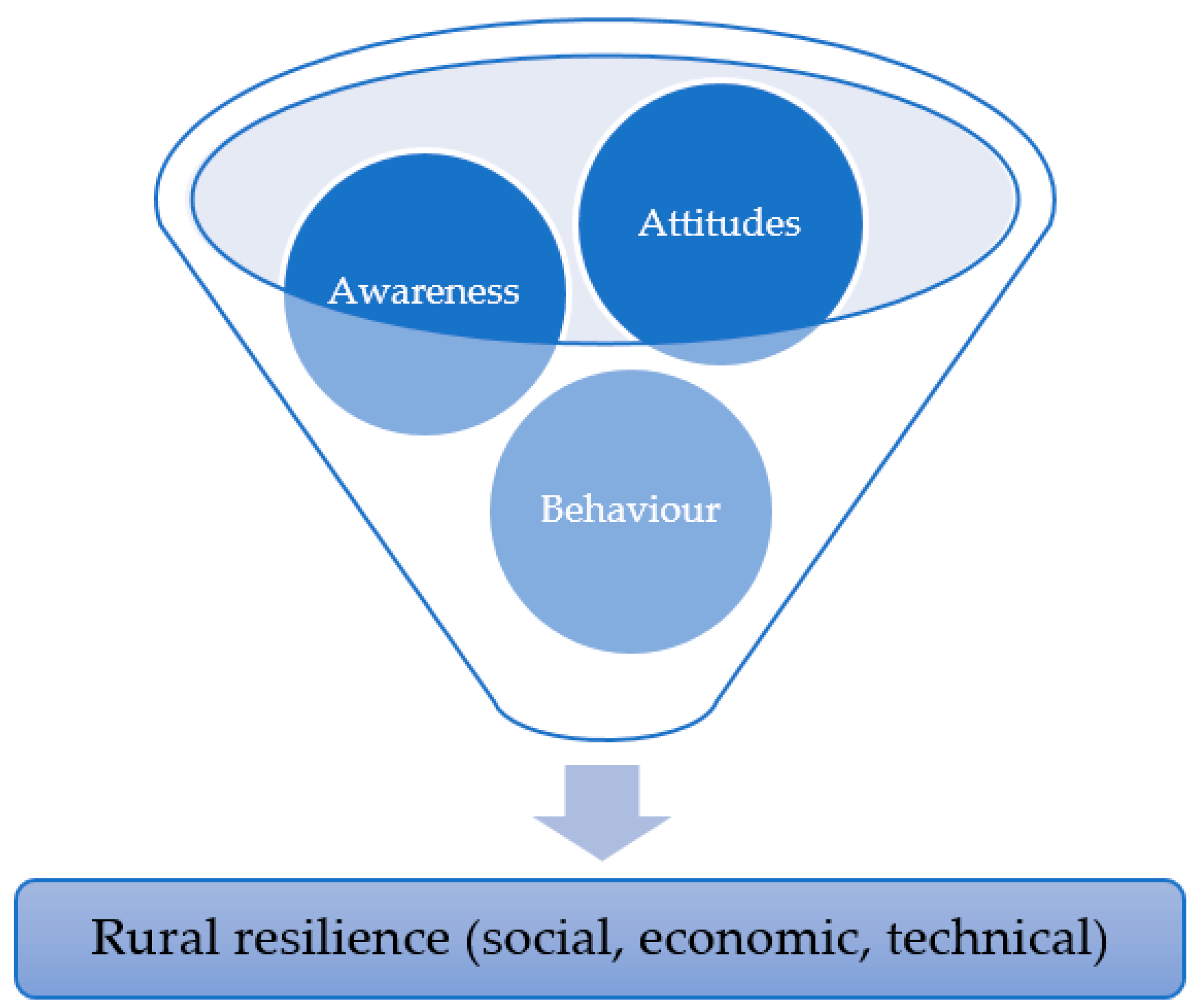
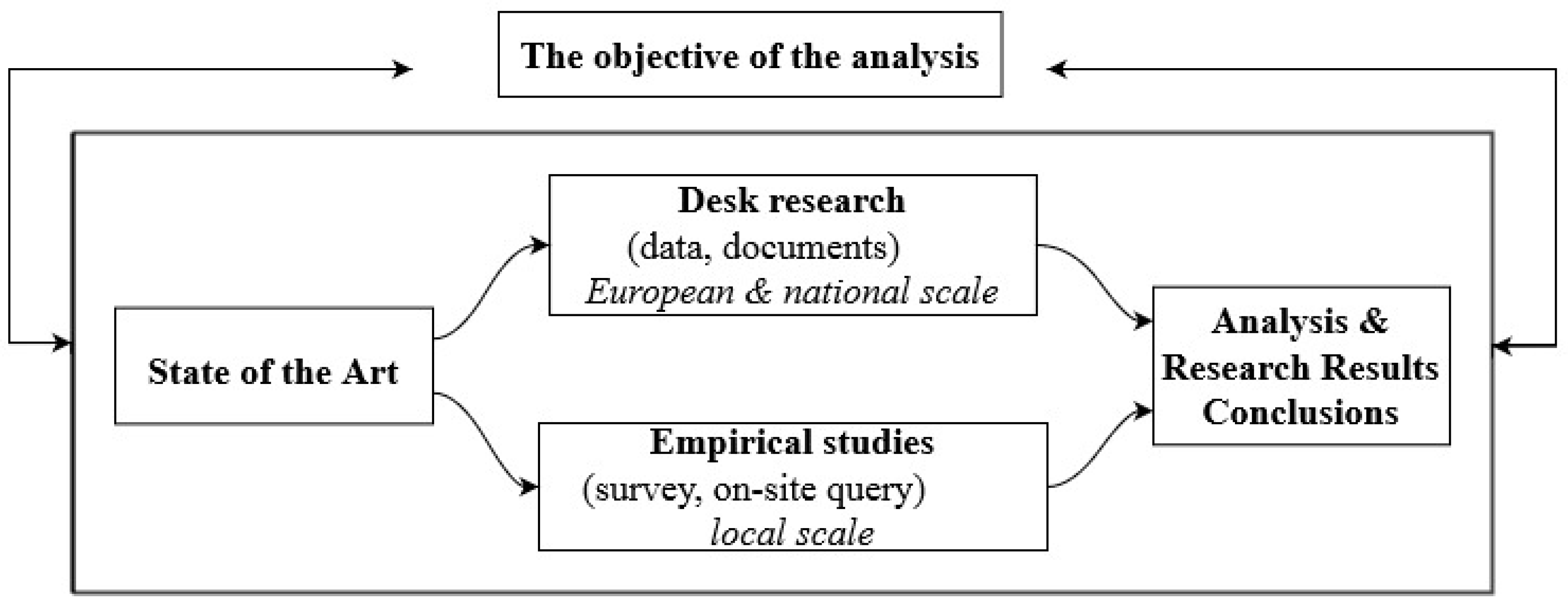

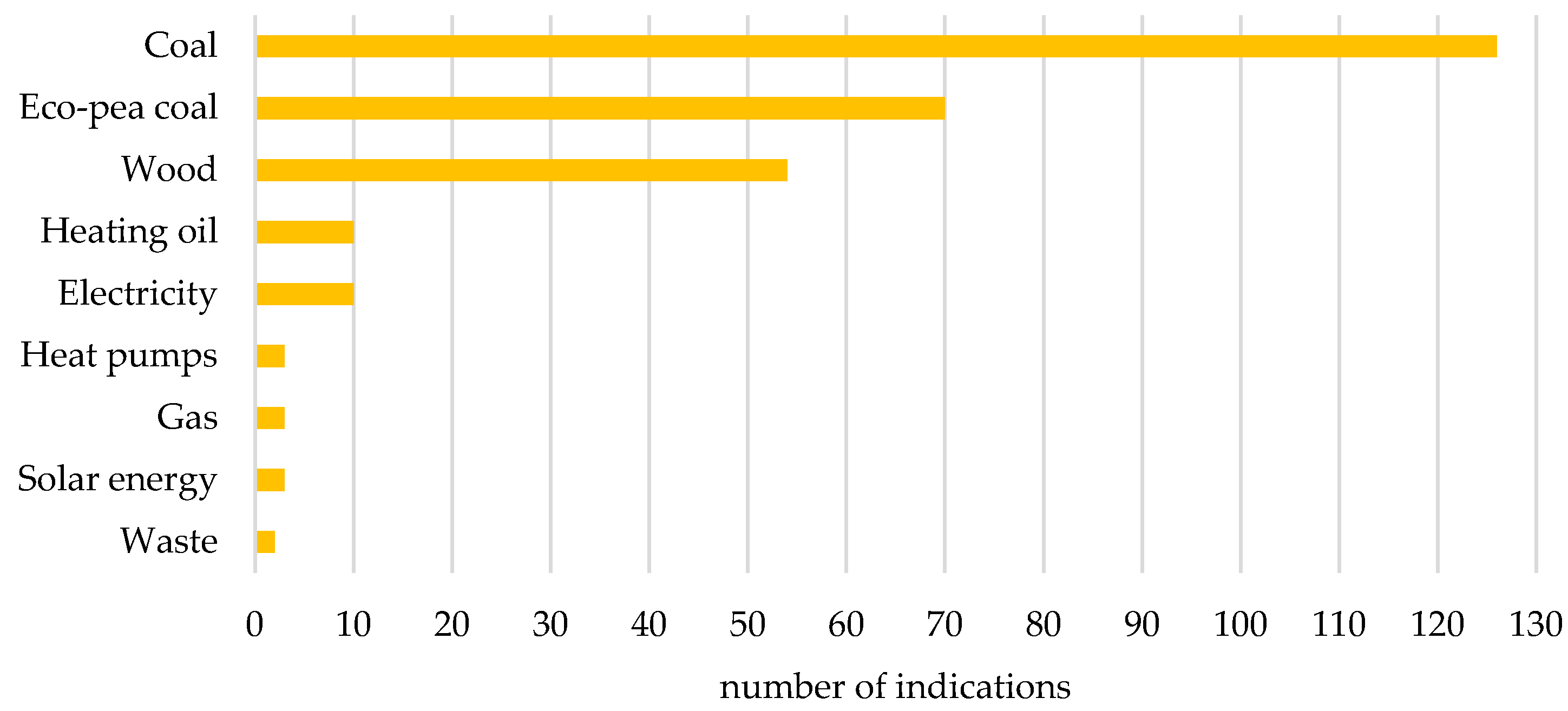
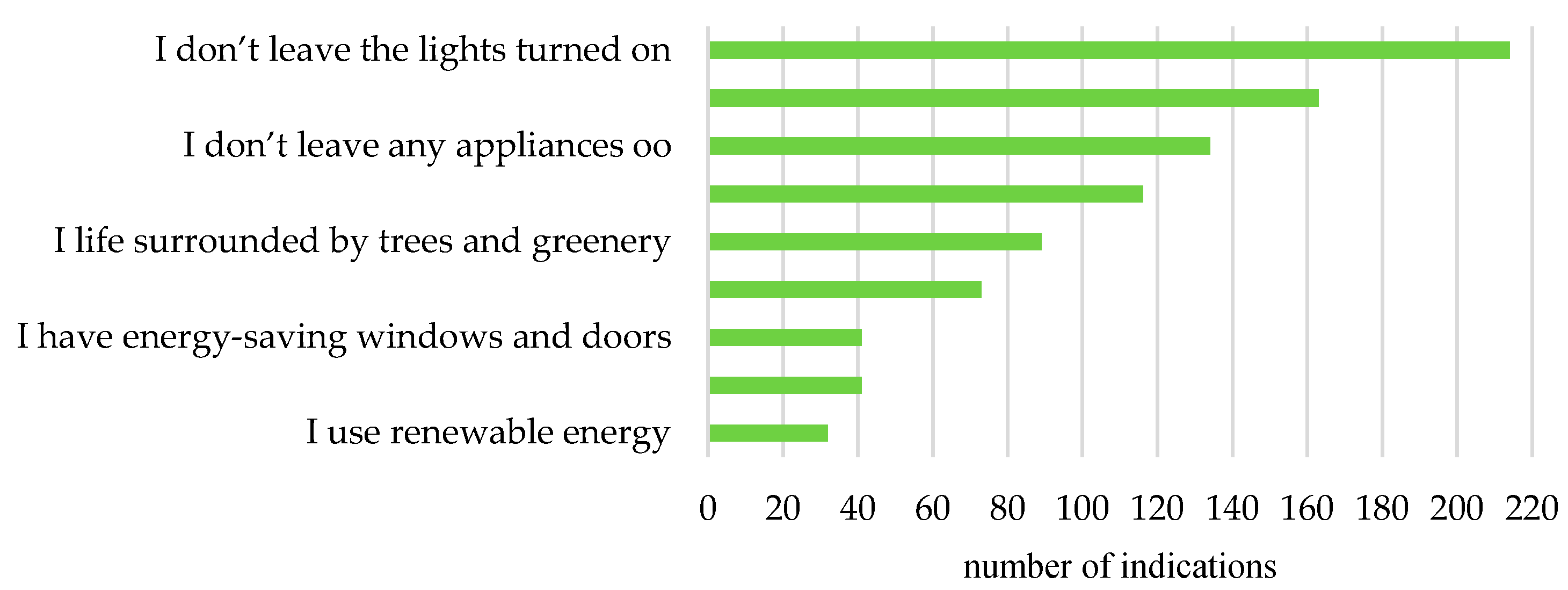


| Population | Female | Male | Number of Employed | Population Density |
|---|---|---|---|---|
| 14,386 | 7255 | 7131 | 1670 | 81 persons/km2 |
| Gender | Time of Residence in the Commune | Type of Building Occupied | ||||||
|---|---|---|---|---|---|---|---|---|
| F | M | less than a year | 1–5 years | 6–10 years | More than 10 years but not since birth | Since birth | Single-family house | Apartment in a multi-family house |
| 59.7% | 40.3% | 1.7% | 9.7% | 14.0% | 31.3% | 43.3% | 84.1% | 15.9% |
| Country | Population | Total Energy | Natural Gas | Hard Coal | Wood | Renewable Energy | ||||||
|---|---|---|---|---|---|---|---|---|---|---|---|---|
| in Thousand | in % | in TJ | in % | in TJ | in % | in TJ | in % | in TJ | in % | in TJ | in % | |
| UE-28 | 511,373 | 100 | 12,056,936 | 100 | 4,345,893 | 100 | 317,419 | 100 | 1,809,026 | 100 | 2,114,326 | 100 |
| UE-15 | 407,194 | 80 | 9,835,796 | 82 | 3,794,743 | 87 | 31,043 | 10 | 1,272,782 | 70 | 1,561,128 | 74 |
| Poland | 37,973 | 7 | 834,683 | 7 | 151,972 | 3 | 267,709 | 84 | 109,725 | 6 | 114,164 | 5 |
| Question | Variants of Answers in the Questionnaire | % of Respondents |
|---|---|---|
| The development of civilization carries, apart from its positive effects, also many negative phenomena and threats. Which of the following phenomena would you consider to be the most dangerous? (N = 1000) | Environment pollution | 58 |
| Desert expansion | 4 | |
| Climate change | 43 | |
| Depletion of non-renewable energy sources | 20 | |
| Growing world population | 12 | |
| Poverty | 41 | |
| Civilization diseases | 51 | |
| The use of chemical compounds and genetic modifications in food products | 42 | |
| Other | 0 | |
| Hard to say | 3 | |
| Do you use the following methods of saving electricity in your household? (N = 990) | Turning off the light when leaving the room (‘definitely yes’ and ‘rather yes’ answers) | 95 |
| Energy-saving light bulbs (‘definitely yes’ and ‘rather yes’ answers) | 87 | |
| Using household appliances and electronics with low electricity consumption (‘definitely yes’ and ‘rather yes’ answers) | 88 | |
| Do you think that your actions can contribute to the improvement of the environment in your town? (N = 1000) | Yes | 67 |
| No | 28 | |
| Hard to say | 5 | |
| Do you think that the focus should now be on development of (N = 992) | Non-renewable energy sources | 5 |
| Renewable energy sources | 50 | |
| Both of these branches of energy equally | 39 | |
| Hard to say | 6 | |
| As part of your investment plans, in the next 2–3 years, do you consider the use of installations enabling the use of renewable energy sources in your home/farm building? (N = 992) | Definitely yes | 7 |
| Rather yes | 15 | |
| Rather not | 32 | |
| Definitely not | 39 | |
| Hard to say | 6 | |
| Not applicable (due to lack of technical conditions) | 1 |
| Respondents’ Financial Situation | Energy Sources Used for Home Heating | ||
|---|---|---|---|
| Coal | Eco-Pea | Wood | |
| I have to be careful with my spending but I am not lacking | 34.0% | 46.0% | 25.0% |
| I don’t have to limit my spending | 17.9% | 13.0% | 30.4% |
| I can afford anything | 0.0% | 3.0% | 3.6% |
| I can afford my basic needs | 45.5% | 36.0% | 41.0% |
| I can’t afford to meet my basic needs | 2.6% | 2.0% | 0.0% |
| Respondents’ Education Structure | Energy Sources Used for Home Heating | ||
|---|---|---|---|
| Coal | Eco-Pea | Wood | |
| primary | 17.3% | 9.0% | 19.6% |
| vocational | 29.5% | 20.0% | 41.1% |
| secondary | 37.2% | 38.0% | 25.0% |
| tertiary | 16.0% | 33.0% | 14.3% |
| Respondents’ Time of Residence in the Commune | Energy Sources Used for Water Heating | ||
|---|---|---|---|
| Coal | Eco-Pea | Wood | |
| less than a year | 0.0% | 5.7% | 0.0% |
| 1–5 years | 6.3% | 8.6% | 11.1% |
| 6–10 years | 14.3% | 8.6% | 9.3% |
| more than 10 years but not since birth | 26.2% | 32.9% | 24.1% |
| since birth | 53.1% | 44.3% | 55.5% |
| Respondents’ Education Structure | Number of Actions Taken to Reduce Energy Consumption at Home | |
|---|---|---|
| At Most Two Actions | At Least Three Activities | |
| primary | 20.8% | 9.6% |
| vocational | 24.6% | 23.5% |
| secondary | 40.8% | 39.2% |
| tertiary | 13.8% | 27.7% |
| Age of Respondents | Sources of Information on How to Save Energy | ||||||
|---|---|---|---|---|---|---|---|
| School | Work | Internet | TV | Friends, Family | Books | Courses, Training | |
| 18–24 | 80.0% | 5.1% | 18.6% | 9.7% | 8.3% | 12.9% | 0.0% |
| 25–34 | 20.0% | 30.8% | 26.7% | 19.9% | 11.0% | 9.7% | 33.3% |
| 35–44 | 0.0% | 35.9% | 33.7% | 30.1% | 24.8% | 22.6% | 33.3% |
| 45–64 | 0.0% | 25.6% | 18.6% | 30.7% | 33.0% | 35.5% | 33.3% |
| 65 and over | 0.0% | 2.6% | 2.3% | 9.7% | 22.9% | 19.4% | 0.0% |
| Energy Sources Used to Heat the Home | How RES-Equipped Homes Stand Out? | ||||
|---|---|---|---|---|---|
| They Are More Ecological | They Are Fashionable | They Are Cheaper to Operate | They Meet the Highest Standards of Construction | You Can Sell Them at a Higher Price | |
| coal | 43.9% | 50.8% | 53.3% | 45.5% | 50.0% |
| eco-pea | 23.5% | 20.6% | 26.7% | 33.3% | 23.1% |
| wood | 20.4% | 19.0% | 15.6% | 18.2% | 23.1% |
| gas | 5.1% | 6.4% | 0.0% | 0.0% | 1.9% |
| electricity | 5.1% | 1.6% | 4.4% | 3.0% | 1.9% |
| solar energy | 1.0% | 0.0% | 0.0% | 0.0% | 0.0% |
| heat pumps | 1.0% | 1.6% | 0.0% | 0.0% | 0.0% |
Publisher’s Note: MDPI stays neutral with regard to jurisdictional claims in published maps and institutional affiliations. |
© 2021 by the authors. Licensee MDPI, Basel, Switzerland. This article is an open access article distributed under the terms and conditions of the Creative Commons Attribution (CC BY) license (https://creativecommons.org/licenses/by/4.0/).
Share and Cite
Chodkowska-Miszczuk, J.; Kola-Bezka, M.; Lewandowska, A.; Martinát, S. Local Communities’ Energy Literacy as a Way to Rural Resilience—An Insight from Inner Peripheries. Energies 2021, 14, 2575. https://doi.org/10.3390/en14092575
Chodkowska-Miszczuk J, Kola-Bezka M, Lewandowska A, Martinát S. Local Communities’ Energy Literacy as a Way to Rural Resilience—An Insight from Inner Peripheries. Energies. 2021; 14(9):2575. https://doi.org/10.3390/en14092575
Chicago/Turabian StyleChodkowska-Miszczuk, Justyna, Maria Kola-Bezka, Agata Lewandowska, and Stanislav Martinát. 2021. "Local Communities’ Energy Literacy as a Way to Rural Resilience—An Insight from Inner Peripheries" Energies 14, no. 9: 2575. https://doi.org/10.3390/en14092575
APA StyleChodkowska-Miszczuk, J., Kola-Bezka, M., Lewandowska, A., & Martinát, S. (2021). Local Communities’ Energy Literacy as a Way to Rural Resilience—An Insight from Inner Peripheries. Energies, 14(9), 2575. https://doi.org/10.3390/en14092575






